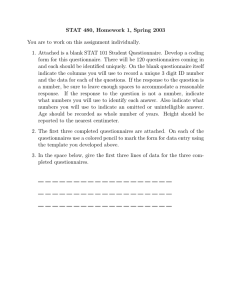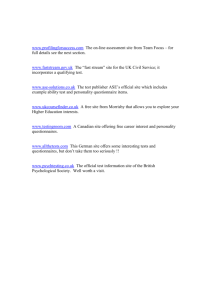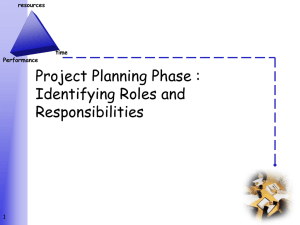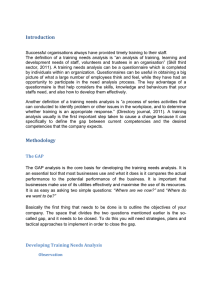Headteacher guidance on issuing pre-inspection questionnaires
advertisement
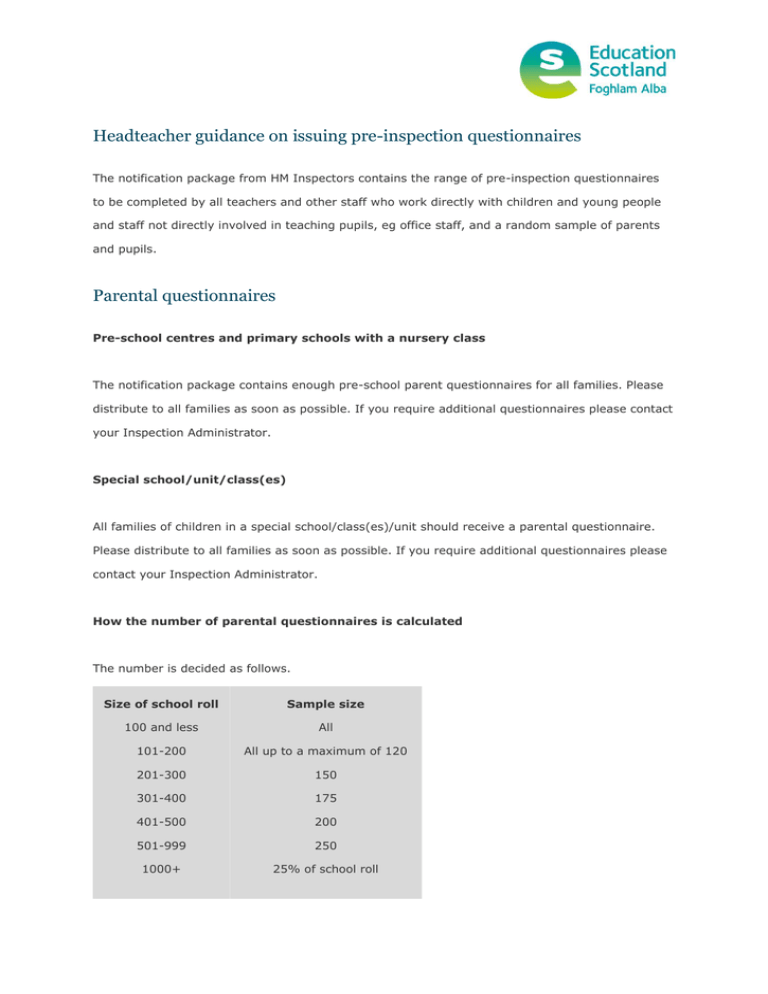
Headteacher guidance on issuing pre-inspection questionnaires The notification package from HM Inspectors contains the range of pre-inspection questionnaires to be completed by all teachers and other staff who work directly with children and young people and staff not directly involved in teaching pupils, eg office staff, and a random sample of parents and pupils. Parental questionnaires Pre-school centres and primary schools with a nursery class The notification package contains enough pre-school parent questionnaires for all families. Please distribute to all families as soon as possible. If you require additional questionnaires please contact your Inspection Administrator. Special school/unit/class(es) All families of children in a special school/class(es)/unit should receive a parental questionnaire. Please distribute to all families as soon as possible. If you require additional questionnaires please contact your Inspection Administrator. How the number of parental questionnaires is calculated The number is decided as follows. Size of school roll Sample size 100 and less All 101-200 All up to a maximum of 120 201-300 150 301-400 175 401-500 200 501-999 250 1000+ 25% of school roll How a random sample is achieved The selection should be obtained by splitting the number of questionnaires proportionately across the stages depending on the total number of pupils at each stage. If the school has relatively few ethnic groups represented in the school then steps should first be taken to ensure that parents of these pupils receive a questionnaire. Thereafter, pick the names from the alphabetical class list, starting at the top of each list, missing out pupils at regular intervals until the required total is reached. For example, where 10 are to be sampled from a class of 30, select every third name. In order to avoid a pupil's family receiving more than one questionnaire, arrangements should be made to first identify families of senior pupils which will get a questionnaire. Thereafter the names of siblings should be removed from the lower stages alphabetical class list(s) and the same method applied to identify families to receive a questionnaire. Pupil questionnaires Guidance on the administration of the pupil questionnaire The notification package contains the pupil questionnaires which are used to cover a representative, randomly selected sample, across the stages. How the number of questionnaires is calculated Calculation of sample numbers for primary pupil questionnaires is as follows: school roll divided by 7, then multiplied by 4 – ie roll = (231 ÷ 7) x 4 = 132 secondary pupil questionnaires please use figures below. Number of pupils (P4/P7) Sample size Number of pupils in school (secondary) 100 and less all 101-200 all up to max 120 201-300 150 301-400 175 401-500 200 501-999 250 1000+ 25% How a random sample is achieved The selection should be obtained by splitting the number of questionnaires proportionately across the stages depending on the total number of pupils at each stage. Pick the names from the alphabetical class list, starting at the foot of each list, missing out pupils at regular intervals until the required total is reached. For example, where 10 are to be sampled from a class of 30, select every third name. Guidance to help administer the pupil questionnaire is set out below - this should be read by all the teachers involved. Guidance for administering the pupil questionnaire The pupil questionnaire should be completed by a sample of children in primary stages P4-P7 and in secondary S1-S6. Please issue the written questionnaire if it is appropriate to do so. Please give your pupils the following details: General information from parents and carers, teaching and staff not directly involved in teaching and pupil questionnaires is being collected in your school. It is important that pupils give their own views about the school - their views are valued. The views of parents and carers, staff and pupils can be used to make the school better. The questionnaire should take no more than 10 minutes to complete. Read each statement in the questionnaire carefully. Please tick the answer that best fits your experience of the school. Give your own answers - your views count. If you are not sure about any answer, or if you want to say a bit more, you can write a note on the blank space on page 2 of the questionnaire. Note: Please explain to children not selected to complete a questionnaire that HM Inspectors take the views of a random sample. Where pupils indicate a particular request to complete a questionnaire, they should be allowed to do so. We have enclosed a small supply of questionnaires marked 'additional sample'. Administration Please make sure that pupils have privacy to complete the questionnaires. You should reassure pupils that once they have completed the questionnaire, no-one in the school will see their answers. The Inspectors will not tell anyone about what a pupil has written unless they are worried about the pupil's safety. In that case they will talk to the pupil and pass on what they have said to someone who can help. Children should seal their questionnaires into the envelope provided. Please return the envelopes containing the completed questionnaires to the school office. They will be posted to Education Scotland in the pre-paid envelope(s) provided. For some pupils with additional support needs you may wish to provide a member of staff or senior pupil to read the questionnaire to the pupil. If it is a teacher, it should not be the usual class teacher. The Managing Inspector would welcome your views on this matter and, in case of doubt, would be happy to discuss arrangements with the school. Children and readers should be given instructions and assurances about anonymity. The reader should give instructions and read questions clearly and in a neutral tone. Care should be taken not to influence the children's answers. Please thank pupils for completing the questionnaire. Sample questionnaires Education Scotland conducts a range of analysis to allow us to monitor and review our inspection procedures. The range of questionnaires and baselines for responses is provided on our website within each sector in the About inspection and review section.

